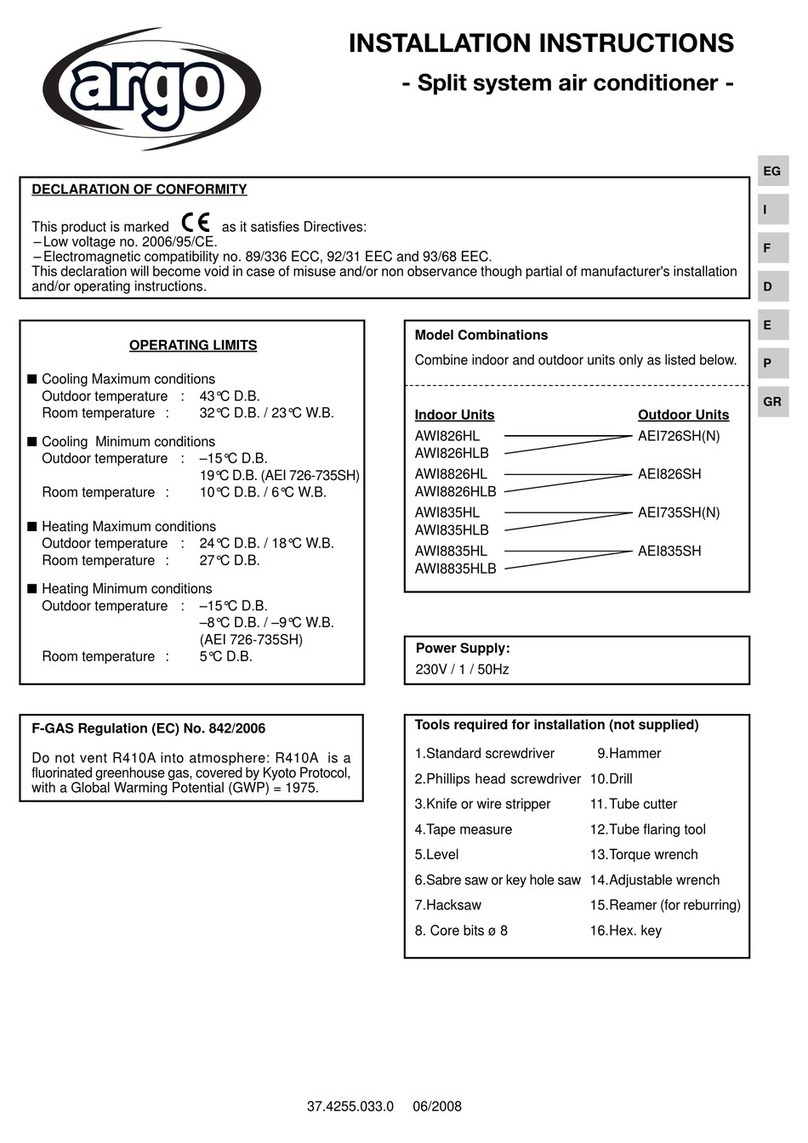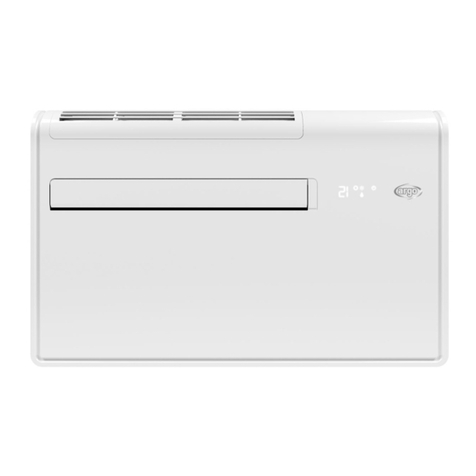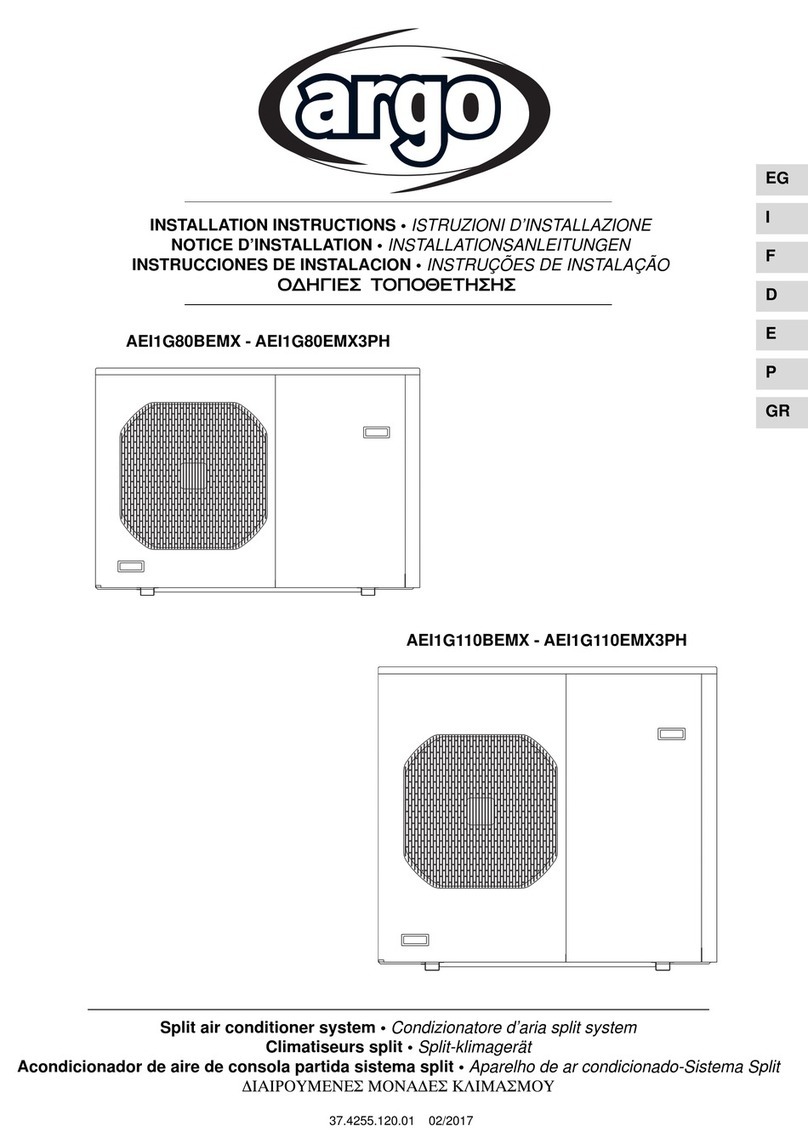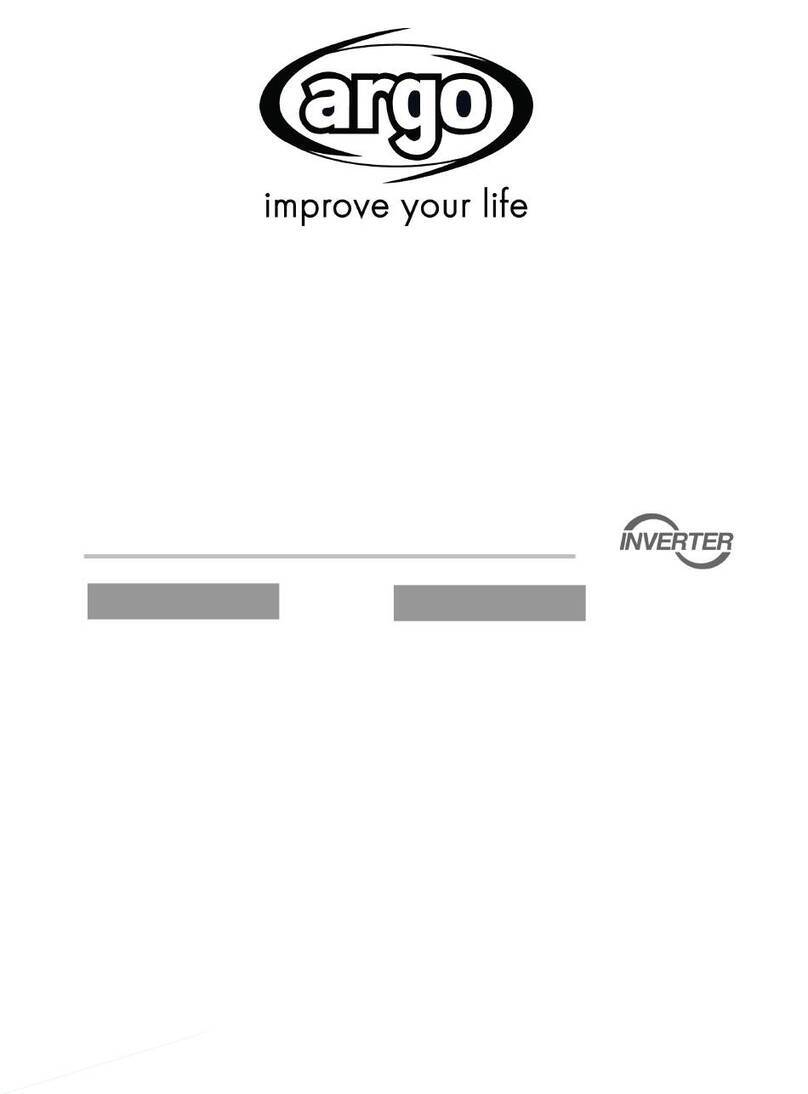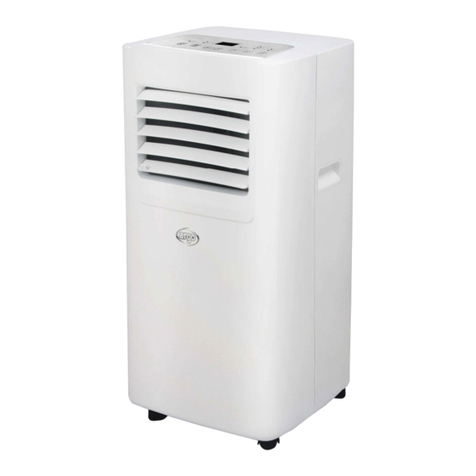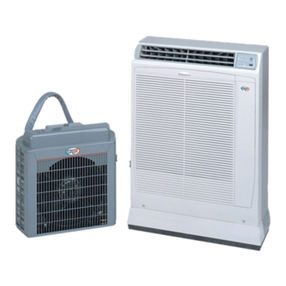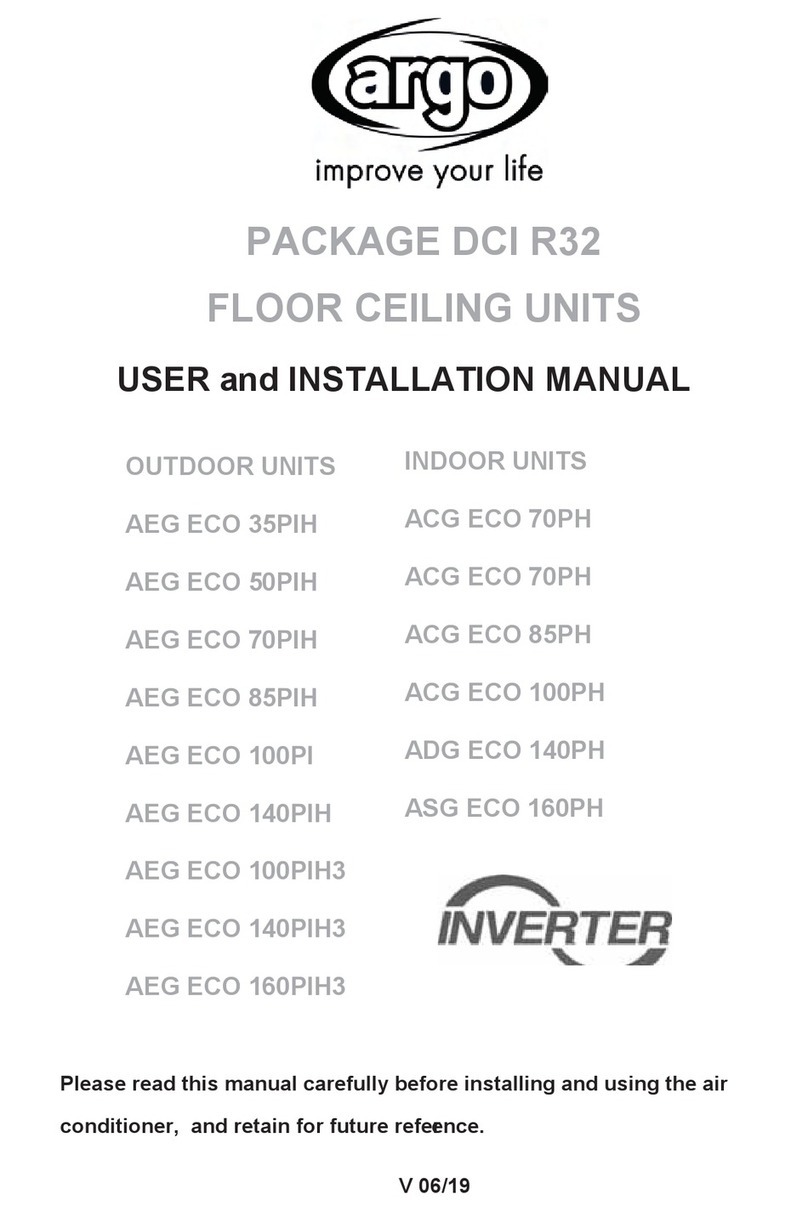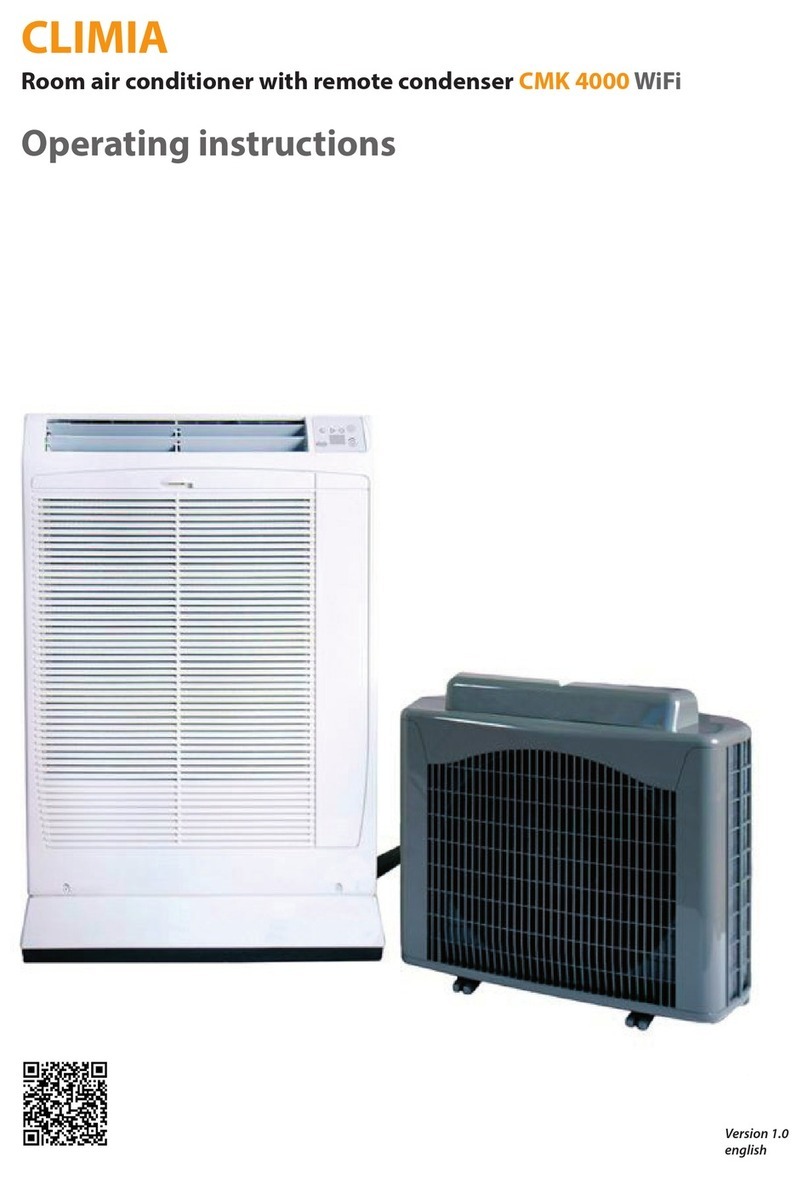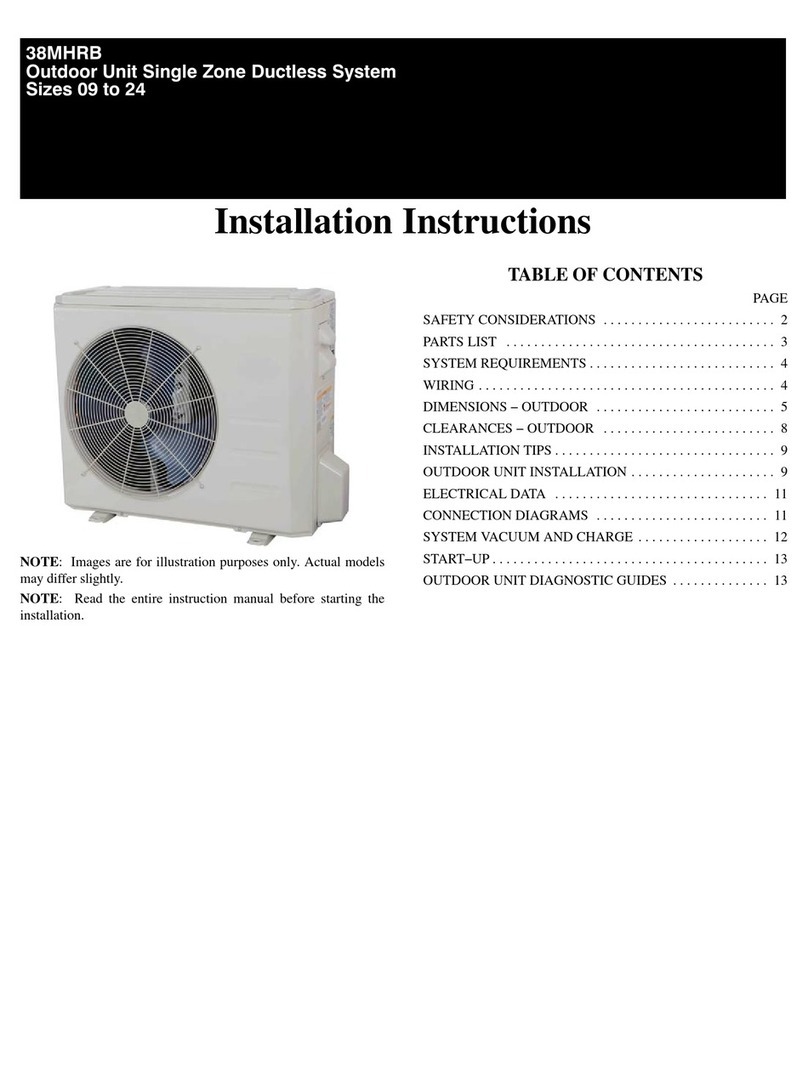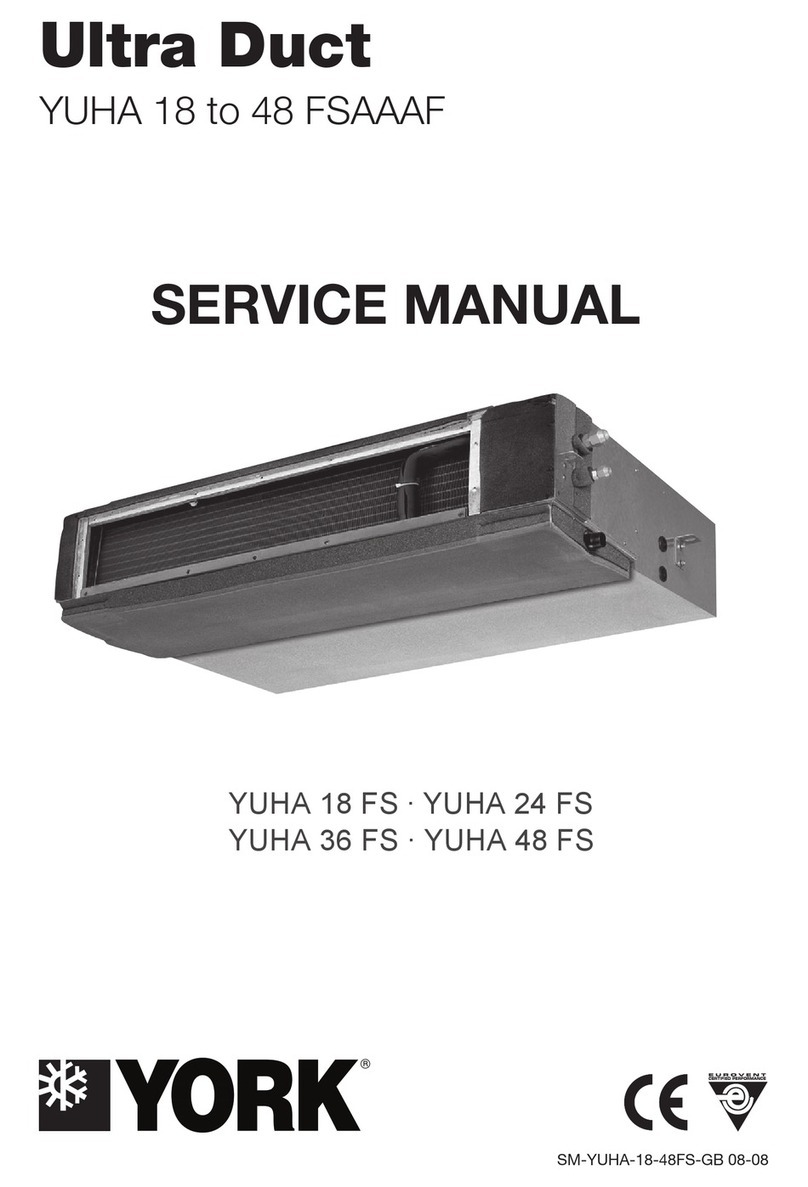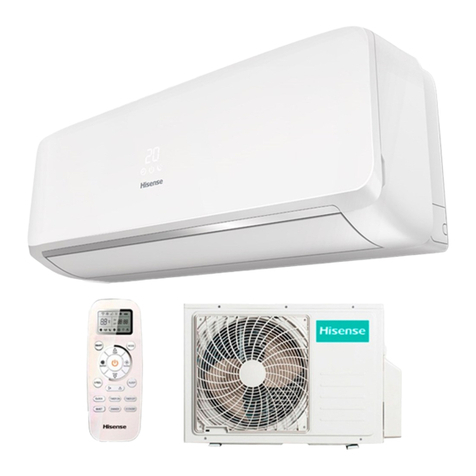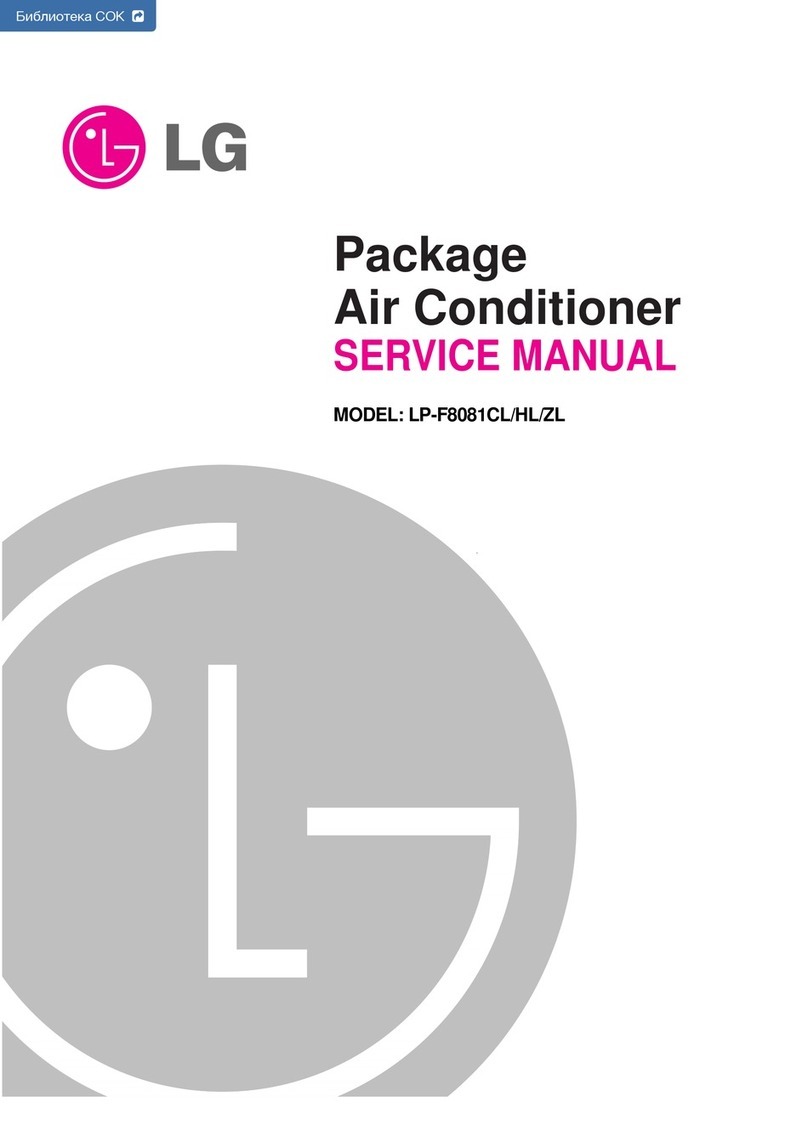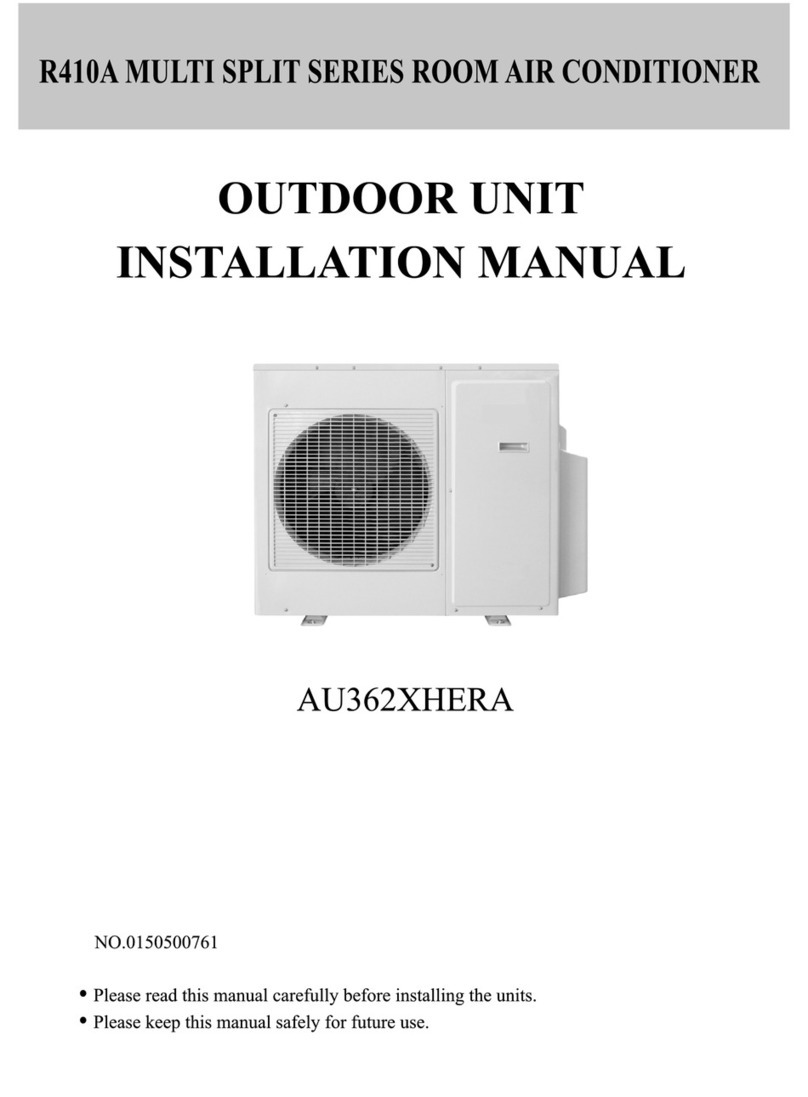Argo SWAN EVO User manual

17
V 11/18
PORTABLE AIR CONDITIONER (LOCAL)
SWAN EVO
OPERATING INSTRUCTIONS
Read the instructions carefully before operating the appliance or carrying out maintenance work.
Observe all the safety instructions; failure to do so may lead to accidents and/or damage. Store these
instructions in a safe place for future reference.
EN

18
V 11/18
The Refrigerant R290
•To realize the function of the air conditioner unit, a special refrigerant circulates in the
system. The refrigerant is the fluoride R290 = 3 GWP (Global warming potential). This
refrigerant is flammable and inodorous. It can lead to explosions under certain
conditions, however the flammability of this refrigerant is very low and it can be ignited
only by fire.
•Compared to other common refrigerants, R290 is a non-polluting refrigerant with no
harm to the ozonosphere and a no effect upon the greenhouse effect. R290 has very
good thermodynamic features which lead to a really high energy efficiency. The units
therefore need less filling.
Warning:
Do not try to accelerate the defrosting process or to clean the appliance in different ways other
than those recommended by the manufacturer. Should repair be necessary, contact your
nearest authorized Argoclima Service Centre. Any repairs carried out by unqualified personnel
may be dangerous. The appliance has to be stored in a room
continuously operating ignition sources. (for example: open flames, an operating gas
appliance or an operating electric heater.) Do not pierce or burn.
Appliance has to be installed, operated and stored in a room with a floor area larger than 7 m2.
ly for appliances filled with R290
flammable gas. Be aware that refrigerants do not have any odour.
Appliance filled with flammable gas R290.
Before repairing the appliance, read the service manual.

19
V 11/18
GENERAL OPERATING AND SAFETY INSTRUCTIONS
•This appliance is a local air conditioner designed for domestic use.
•Only use this air-conditioner as described in this manual.
•Ensure that the required voltage and frequency (220-240V/50 Hz)
match the available power source.
•Fuse style 5ET or SMT 250V, the electricity passing through the
fuse cannot be above 3.15A.
•This appliance can be used by children aged from 8 years and
above and people with reduced physical, sensory or mental
capabilities or lack of experience and knowledge if they have been
given supervision or instruction concerning use of the appliance in a
safe way and understand the hazards involved.
•Children shall not play with the appliance.
•Cleaning and user maintenance shall not be made by children
without supervision.
•Ensure that the electricity system is able to deliver the operating
current required by the air conditioner, in addition to that normally
absorbed by other appliances (household appliances, lighting
system, etc.). Please refer to the maximum power input data
indicated on the air conditioner's data plate.
•Connection to the electricity grid must take place in accordance with
current installation standards.
•Ensure that the automatic switches and system protection valves
are able to withstand a start-up current of 6A (normally for less than
1 second).
•The system socket must always be fitted with an efficient earth
connection.
•Make sure that the plug is fully inserted. Do not use multiple
adapters. Do not touch the plug with wet hands. Make sure that the
plug is clean.

20
V 11/18
•Do not use the plug as a means by which to start/stop the air
conditioner: use the ON/OFF button on the remote control or on the
control panel.
•Do not install the air conditioner in rooms where it may receive
water splashes (e.g. laundry rooms).
•This air conditioner can be used by children of 8 years of age or
older, and by persons with reduced physical, sensory and mental
abilities or who lack the necessary know-how and experience to
operate it, if under the supervision or instruction of a person
responsible for their safety, so that they are fully aware of the
attendant risks.
•Before moving or cleaning the device, ensure that it is unplugged
from the socket.
•Do not move the air conditioner while it is operating; first turn the
appliance off, check for any condensate build-up and empty it if
necessary.
•To turn the appliance off, set the remote control to OFF and remove
the plug from the socket. Pull on the plug only. Do not pull the cord.
•Do not use the appliance if the cord or plug are damaged. If the
power supply cord is damaged, it must be replaced by the
manufacturer, dealer or a similarly qualified person so as to avoid
any safety risks.
•Keep the unit away from fire, possible fire sources, inflammable or
explosive objects.
•
and unplug it.
•
than 0°C. It can cause water leakage to the air conditioner.
•Do not splash or pour water on the air conditioner

21
V 11/18
PRECAUTION!
•Do not insert any objects into the air conditioner: this is very
dangerous as the fan turns at high speed.
•Ensure that air circulates freely around the unit. Do not cover
the air intake and delivery grilles with drapes or any other
means.
WARNING!
•The air conditioner must be positioned at least 50 cm from the wall
or any other obstacles, on a flat and stable surface so as to avoid
water leaks.
•The air conditioner is fitted with a system for protecting the
compressor from overload. This means that the compressor
only starts 3 minutes after its previous stoppage.
•Please wait at least 3 minutes before starting the unit. This
helps prevent the compressor from being damaged.
WARNING!
In the event of an anomaly, switch the appliance off and unplug
it from the socket. Do not dismantle or attempt to repair or
modify the product. In the event of a malfunction, contact the
service centre directly.
WARNING!
•Do not expose the air conditioner to direct sunlight, as the
colour of the materials may change; moreover, the appliance
may overheat causing the protection mechanism to intervene
and switch the appliance off.
•Do not use insecticides, oils, detergents or spray paints near
the appliance; do not use aggressive chemical detergents to
clean the casing: this may damage the finish and colour.

22
V 11/18
•Close all open windows to maximise air conditioning
efficiency.
The manufacturer will not be held liable if safety and accident
prevention rules are not observed.

23
V 11/18
DESCRIPTION OF THE APPLIANCE
FRONT VIEW
REAR VIEW
Min/max operating limits (internal temperature)
Cooling: 7°C DB / 35 °C DB
Dehumidification: 17°C DB / 35 °C DB
Cooling mode room temperature adjustment range: 16 °C DB / 31 °C DB
1) UPPER PANEL
2) HANDLE
3) REAR STRUCTURE
4) SWIVEL CASTERS
5) CONTROL PANEL –BUTTONS FOR
OPERATION WITHOUT REMOTE CONTROL
6) FINS AND AIR FLOW OUTLET
7) FRONT STRUCTURE
8) AIR INTAKE
9) DRAINAGE HOLE FOR DEHUMIDIFICATION
FUNCTION
10) AIR OUTLET AND FITTING
11) AIR INTAKE
12) DRAINAGE HOLE FOR COOLING FUNCTION
13) FRONT STRUCTURE
14) HANDLE
15) REAR STRUCTURE
9) H
1
(4)

24
V 11/18
PRE-OPERATING CHECKS AND OPERATIONS
The following space must be maintained to ensure the operating efficiency of the portable air conditioner.
APPLIANCE START-UP
Open the packaging and pull out the box. Remove the product and the other elements supplied (illustrated in the box
below).
Infrared remote control
Type-AAA LR03 1.5 V
batteries for remote control.
(Not provided)
Flexible pipe inclusive of fitting for unit and end
fitting for window
Round fitting for window unit, to
be positioned between the end
of the tube and the window unit
itself
Window unit kit with plug.
Position the product vertically on a flat and stable surface, as close as possible to a window and at least 50 cm from
walls or other nearby obstacles.
50 cm
50 cm

25
V 11/18
USE WITH END FITTING FOR WINDOW
1. Stretch the flexible hose sufficiently so that it
reaches the outside (max 1.5 m) and hook it to the rear
part of the air conditioner.
2. Open the window and lock one of the two leaves
with the handle.
Rest the terminal connection on the fixed leaf,bring
the other leaf of the window close.
3. Open the window and lock one of the two leaves
with the handle.
Rest the terminal connection on the fixed leaf,bring the
other leaf of the window close.
4. Avoid tight bends or folds in the flexible pipe.

26
V 11/18
USE WITH WINDOW UNIT KIT
1. To make the hole in the glass it is advisable to
take the porthole kit accessory to the glazier.
2. Insert the window unit into the window.
3. Insert the round fitting into the retractable flexible
pipe and insert the latter with its round fitting into
the window unit without the plug.
4. Insert the round fitting onto the flexible pipe.
5. Insert the flexible pipe thus mounted into the rear of the
air conditioner.
If the air conditioner is not used for prolonged periods, disconnect the pipe and plug the window unit.
Connect the power cord to a suitable electric socket (220240 V). Insert the supplied batteries into the remote control
and make sure the poles match. Select the desired operating mode from the remote control.

27
V 11/18
HOW TO USE THE APPLIANCE
This appliance can be used for cooling, dehumidifying and ventilation purposes.
Before using the appliance, leave it standing erect for at least two hours.
When switching between modes, the fan continues to turn but the compressor stops: the compressor will re-start after 3
minutes. This delay protects the compressor from potential damage.
THE DRAINAGE TUBE MUST BE CONNECTED to the appliance AT ALL TIMES: the only exception is when the
appliance is used in dehumidification mode only, in which case the appliance should be left to discharge directly
into the room for maximum efficiency (see the “Dehumidification Mode” paragraph).
Clean the air filters under the easily removable rear grille regularly to keep the air conditioner working efficiently.
OPERATING MODES
1. COOLING MODE
•
•The temperature can be adjusted to between 16 °C and 31 °C.
•In this mode, each time the ON/OFF button is pressed the unit switches off, the appliance saves the temperature
setting and retains this setting when it is switched on again.
•In this mode, the fan speed can be adjusted and the Timer and SLEEP functions can be set.
•For more silent operation, run the fan at low speed.
2. DEHUMIDIFICATION MODE (DRY)
•Press the MODE button to select the dehumidification mode.
•The temperature is controlled by the electronic board and cannot be adjusted.
•In this mode, each time the ON/OFF button is pressed the unit switches off, the appliance saves the settings and
retains them when it is switched on again.
•The fan speed is set to low and cannot be adjusted.
NOTE
The air conditioner does not cool the room when operating as a dehumidifier.
When the appliance is used as a dehumidifier, the flexible pipe must not be connected.
For maximum dehumidification efficiency, leave the rear discharge attachment free to discharge directly into
the environment.
The dehumidification mode is recommended during autumn and winter.
Cooling, Fan
Dehumidifying

28
V 11/18
If used during summer, it is best to leave the flexible pipe attached so that the hot air is discharged towards
the outside rather than into the room.
D
3. FAN MODE
•Press the MODE button to select ventilation until the corresponding icon appears.
•In this mode, the fan speed can be adjusted.
•The temperature cannot be adjusted.
HOW TO ELIMINATE CONDENSATE
Manual drainage
Cooling
This appliance automatically vaporises condensate in the cooling mode.
Ensure that when the unit is operating in cooling mode, the rubber caps
closing the drainage holes on the rear of the appliance are properly
positioned.
When the air conditioner operates in cooling mode, there is no need for
continuous condensate drainage; only in specific weather conditions with very
high air humidity levels may water deposit inside the unit. When the container
nal that full
To empty the container, switch the air conditioner off and unplug it. Remove
the cap form the rear drainage hole and direct it over a normal drain.
Ensure that the tube is not twisted or bent. The tube must slope downwards.
Re-close the drainage hole with the cap and resume use of the air conditioner.
Continuous drainage
Dehumidification
WARNING!
When using the air conditioner in dehumidification mode, it is advisable to
always arrange for continuous drainage, so as to maximise dehumidification
efficiency.
Connect one end of the PVC pipe (not provided) to the upper discharge hole
and place the other end above a drain.

29
V 11/18
REMOTE CONTROL OPERATION
1. Slide the cover open in the direction indicated by the
arrow.
2. Insert the batteries (LR03/1.5 V - not provided) into the
remote control and make sure the poles match.
3. Put the cover back on.
4. Point the remote control towards the receiver on the air
conditioner.
5. The remote control should be positioned within 6 metres
from the receiver.
6. There must be no obstacles between the remote control
and the receiver.
7. Do not drop or launch the remote control.
8. Do not leave the remote control under strong sunlight or
heating devices and other source of heat.
9. Remove the batteries from the remote control when the
latter is not used for a long time.
10. If no sound is heard and the transmission symbol on the
display does not flash, the batteries must be replaced.
11. If the system resets when the remote control button is
pressed, the electrical signal is poor and the batteries must
be replaced.
12. Flat batteries must be disposed of correctly.
N.B.:
* The image depicts a general remote control, which contains nearly
all the function keys. These may be of a slightly different material
(depending on the model).
INFORMATION FOR THE CORRECT DISPOSAL OF BATTERIES IN ACCORDANCE WITH EUROPEAN DIRECTIVE
2006/66/EC
Replace batteries when they are depleted. At the end of their life, batteries must be disposed of separately from unsorted waste.
They must be taken to designated recycling centres or returned to a retailer providing this service. Separate disposal of batteries
prevents potential negative effects on the environment and human health due to inadequate disposal, and also allows for
recovering and recycling their constituent materials, resulting in significant savings in terms of energy and resources. The separate
disposal obligation is underlined by the crossed-out dustbin symbol appearing on the battery. Illegal disposal of the product by the
user implies administrative sanctions applied as per current regulations.

30
V 11/18
FOR OPTIMAL REMOTE CONTROL OPERATION, POINT THE TRANSMITTER HEAD TOWARDS THE
RECEIVER ON THE AIR CONDITIONER.
1. ON/OFF BUTTON
2. TIMER BUTTON
3. DOWN BUTTON
4. MODE BUTTON
5. UP BUTTON
6. FAN BUTTON
7. SLEEP BUTTON
(1) ON/OFF BUTTON
Press this button to switch the unit on or off.
(2) TIMER BUTTON
set the time, and press
el the time setting.
(3) DOWN BUTTON
Press this button to adjust the temperature and set the time.
(4) MODE BUTTON
When the unit is on, press this button to choose the desired mode among: COOLING, FAN and DEHUMIDIFYING.
(5) UP BUTTON
Press this button to adjust the temperature and set the time.
(6) FAN BUTTON
In the cooling and fan modes, press this button to adjust the ventilation speed to low (Low) or high (High). In certain
conditions, the fan speed may not function according to the settings.
In dehumidifying mode, this button cannot be pressed, thus the fan will forcefully choose the low fan speed.

31
V 11/18
(7) SLEEP BUTTON
In cooling mode, press the UP and FAN buttons to activate the Sleep mode, after which the unit will return to
the silent mode and save energy.
N.B.: The Sleep function is not available in the dehumidifying or fan modes.
(8) TEMPERATURE AND ERROR DISPLAY
Problem
Cause
Solution
FL
Tank full of water.
Empty the tank.
If the problem persists, contact a service centre.
E1
Room temperature sensor failure.
Contact a service centre.
E2
Failure of temperature sensor on the
evaporator.
Contact a service centre.
CARE AND MAINTENANCE
WARNING!
Before carrying out any cleaning or maintenance operations, unplug the appliance.
1. Cleaning the air filters
The air filters must be checked at least once every two
weeks of use. Operating the appliance with dirty or
clogged filters will decrease the air conditioner's efficiency
and may cause serious problems.
To remove the upper filter, loosen the central screw and
.
Use a vacuum cleaner to remove the dust from the filters.
Should this not suffice, wash the filter with lukewarm water
and some neutral detergent (if necessary), then rinse it
thoroughly in cold water and leave it to dry in air before
putting it back in place. Once the filter has been replaced,
close the grille and resume use of the air conditioner.
2. Cleaning the casing.
Use a damp and soft cloth to clean the outer surface of the appliance.
Do not use excessively hot water, solvents, petrol or other aggressive chemical compounds, talcum powder or brushes:
these may damage the surface or colour of the casing.
Remove any stains using lukewarm water with a little neutral detergent.
Do not pour water onto the air conditioner to clean it, as this may damage its internal components or cause a short-circuit.
3. Storage.
When the air conditioner is not expected to be used for a long time, clean the filters before storing it away.
Keep the appliance in a vertical position at all times. Do not place heavy objects on top of the air conditioner. It is advisable
to protect the appliance with a plastic sheet.
4. Transport.
Transport the air conditioner in the vertical position.
Should this not be possible, rest it on its right-hand side; when the
appliance reaches its final destination, place it immediately in the
vertical position and wait at least 4 hours before operating it in cooling
mode.

32
V 11/18
5. For complete safety, regularly check the condition of the power cord; should it be damaged as a result of wear,
contact the Service Centre to replace it.
TIPS FOR MAXIMISING COMFORT AND MINIMISING CONSUMPTION
CHECK that:
•the unit intake and delivery grilles are always free;
•the air filters are always clean; a dirty filter will decrease the passage of air and reduce the unit's performance;
•all doors and windows are closed, so as to avoid infiltration of unconditioned air;
•the flexible pipe is correctly positioned, without tight bends or curves;
•the room temperature is above 7°C for the cooling mode, and above 17°C for the dehumidifying mode.
REGULATION (EU) No. 517/2014 –F-GAS
The unit contains R290, a natural greenhouse gas with global warming potential (GWP) = 3 - Kg. 0.13 = 0.00039
Tons CO2equiv.
Do not release R290 into the atmosphere.
INFORMATION FOR THE CORRECT DISPOSAL OF THE PRODUCT IN ACCORDANCE WITH EUROPEAN
DIRECTIVE 2012/19/EU
This appliance may not be scrapped with domestic waste at the end of its life cycle. We call your attention to
the crucial role played by the consumer in the re-use, recycling and other forms of recovery of such waste.
The appliance must be scrapped by a sorted waste disposal centre or by returning it to the retailer (no charge is
levied for this service), when you purchase a new equivalent appliance.
Sorted disposal of electric and electronic equipment prevents the negative effects on the environment and
human health resulting from improper scrapping, and also allows the materials from which it is made to be
recovered and recycled, with significant savings in terms of energy and resources.
The sorted disposal requirement is indicated by the crossed waste bin label affixed to the appliance.
www.argoclima.com
Other manuals for SWAN EVO
1
Table of contents
Other Argo Air Conditioner manuals
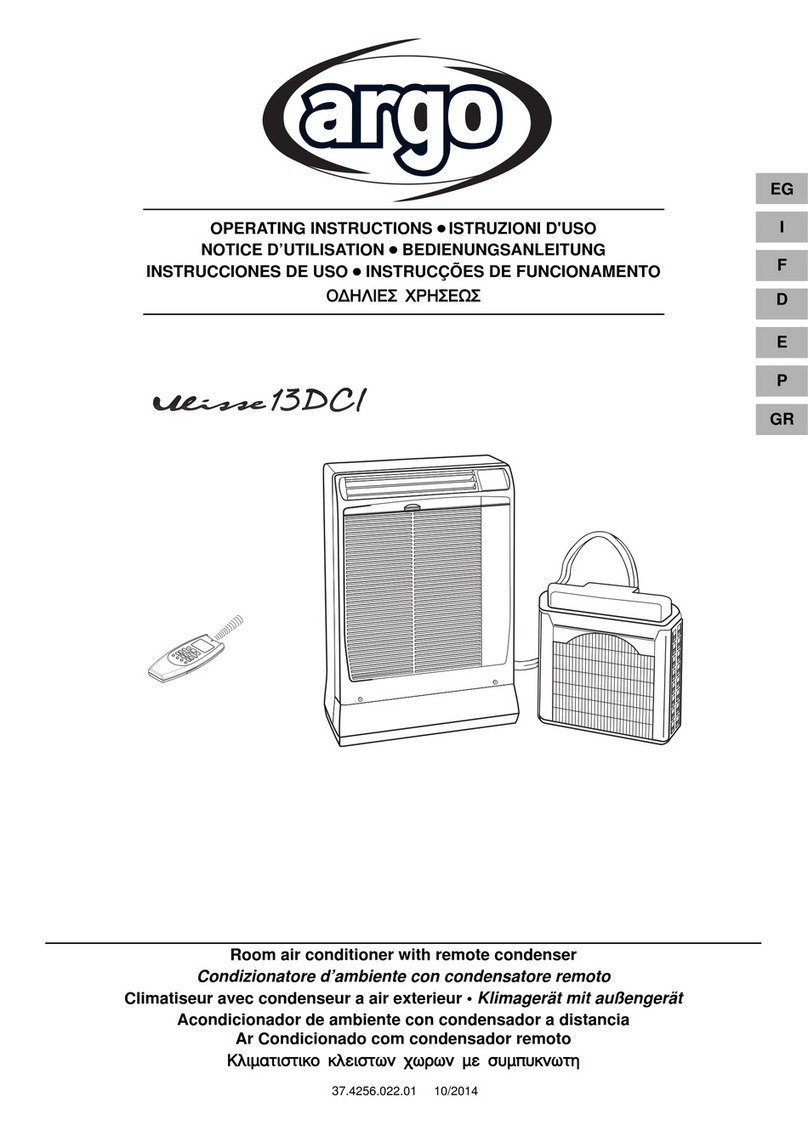
Argo
Argo Misse13DCI User manual
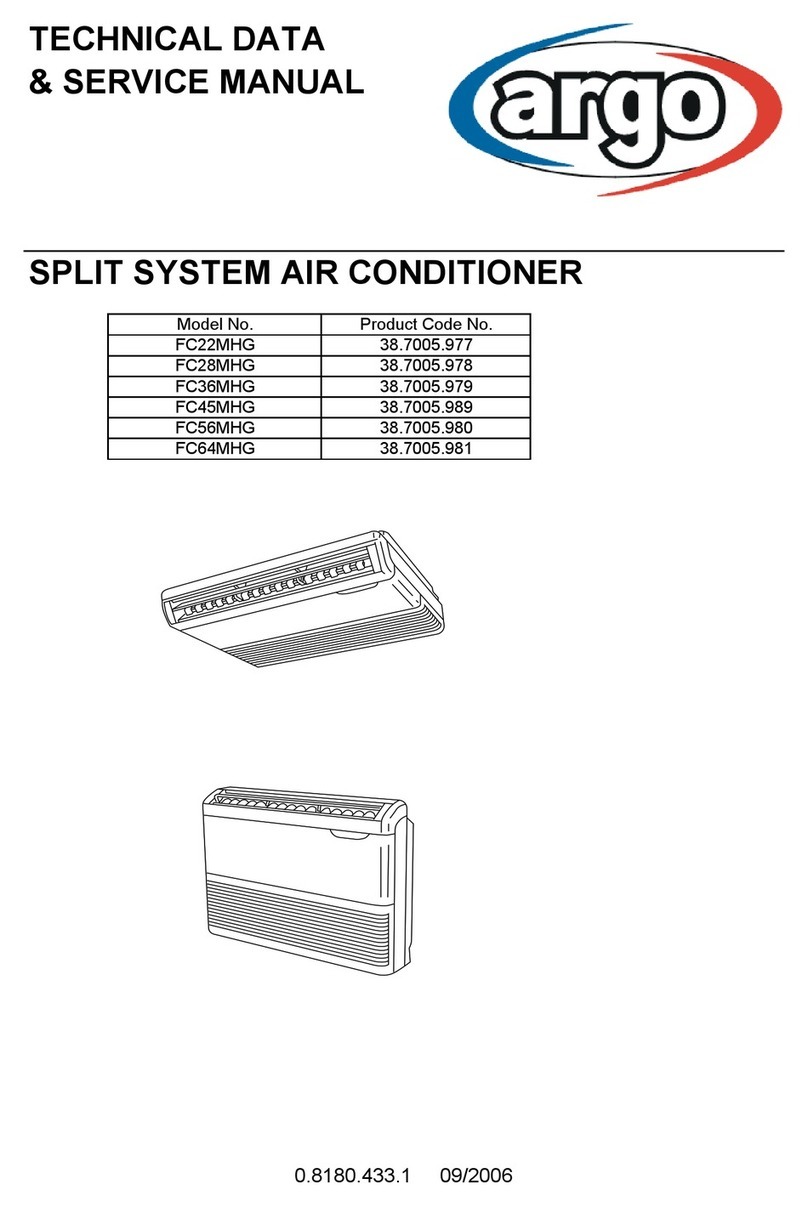
Argo
Argo FC22MHG Manual
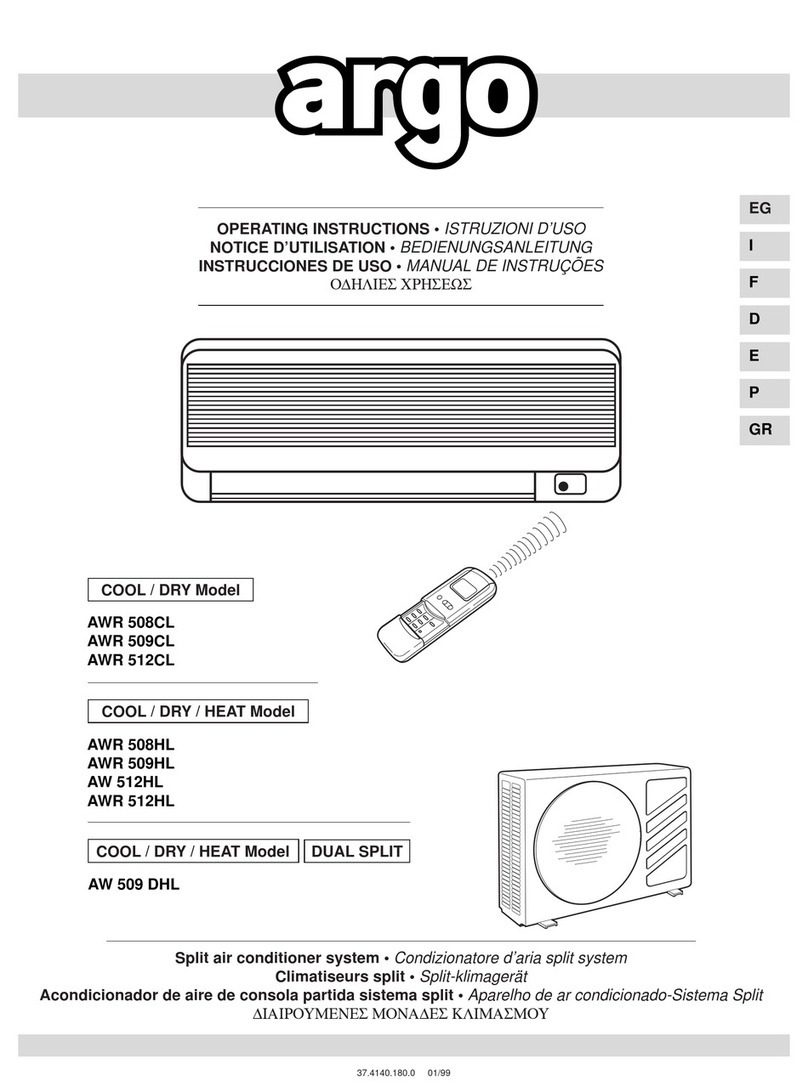
Argo
Argo Euro-Line AWR508CL User manual

Argo
Argo AW22AL User manual
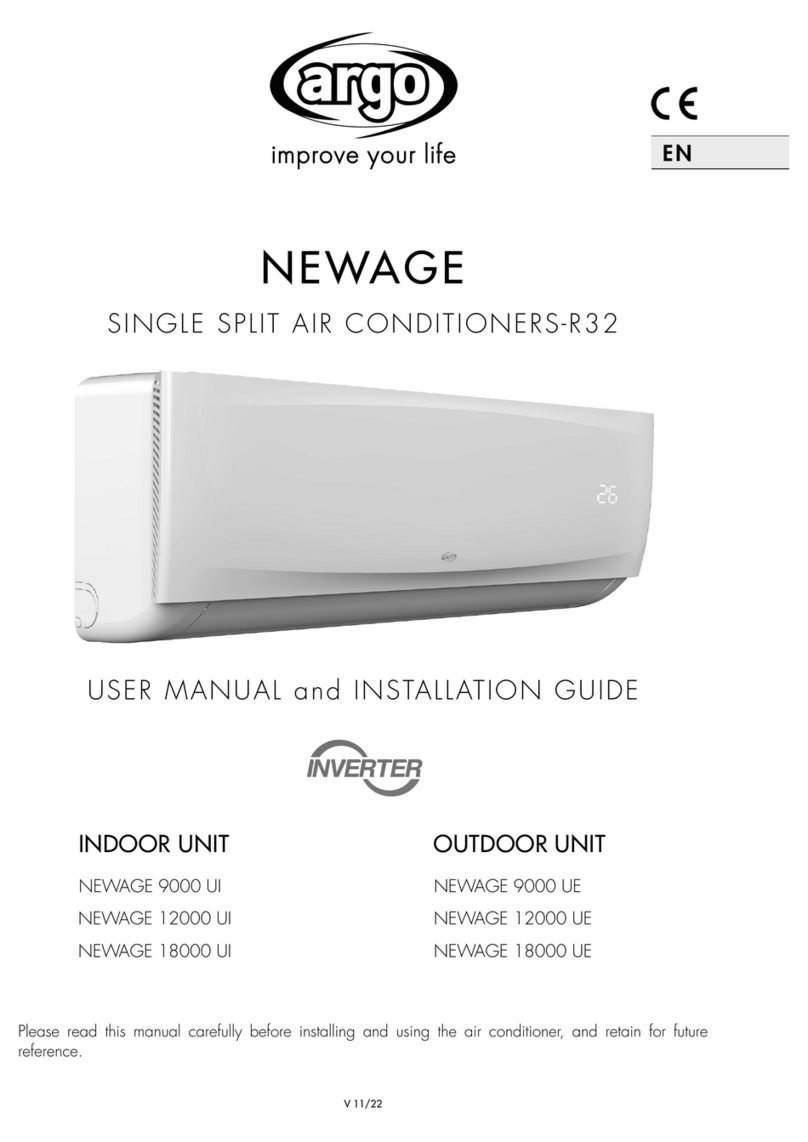
Argo
Argo NEWAGE 9000 UI User manual
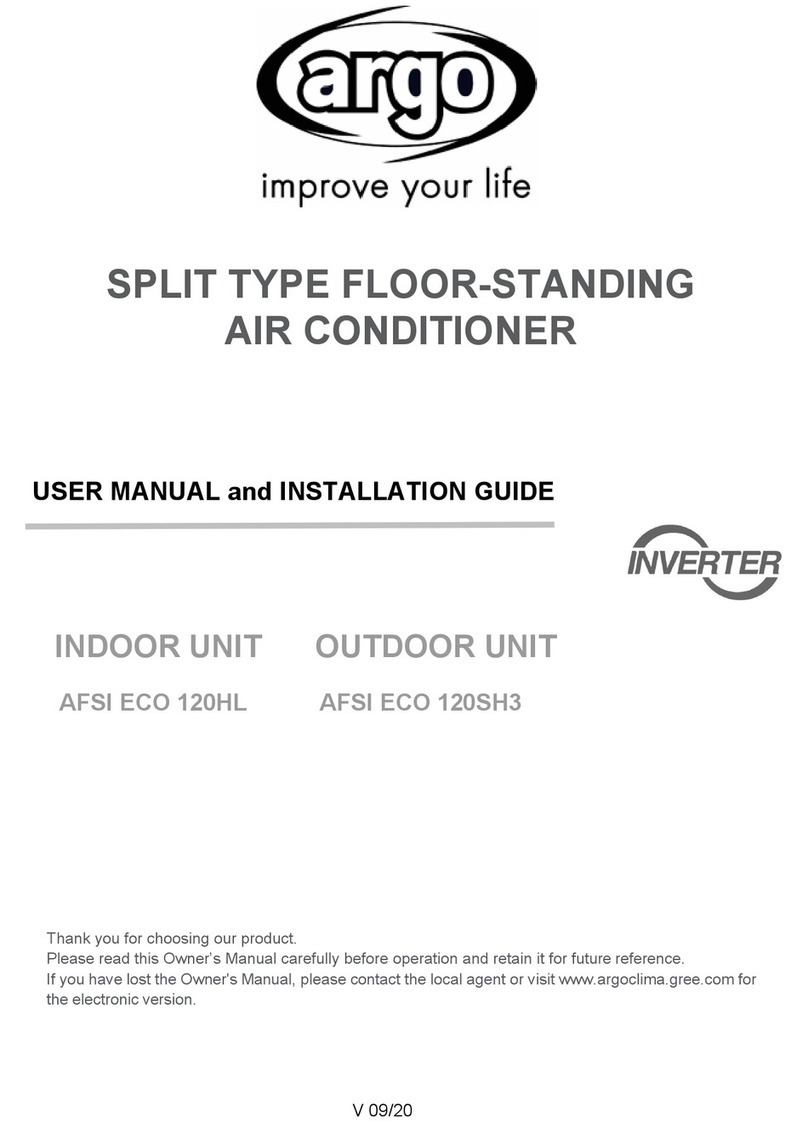
Argo
Argo AFSI ECO 120HL User manual
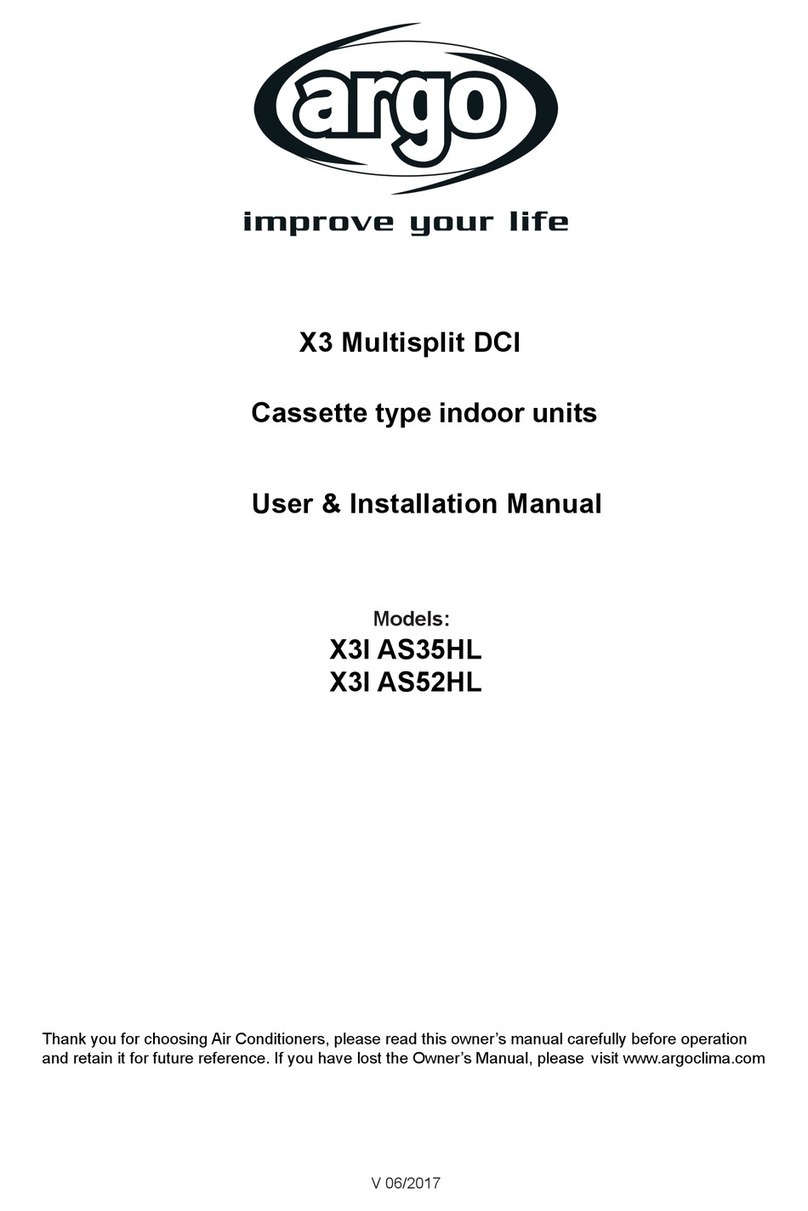
Argo
Argo X3I AS52HL Guide
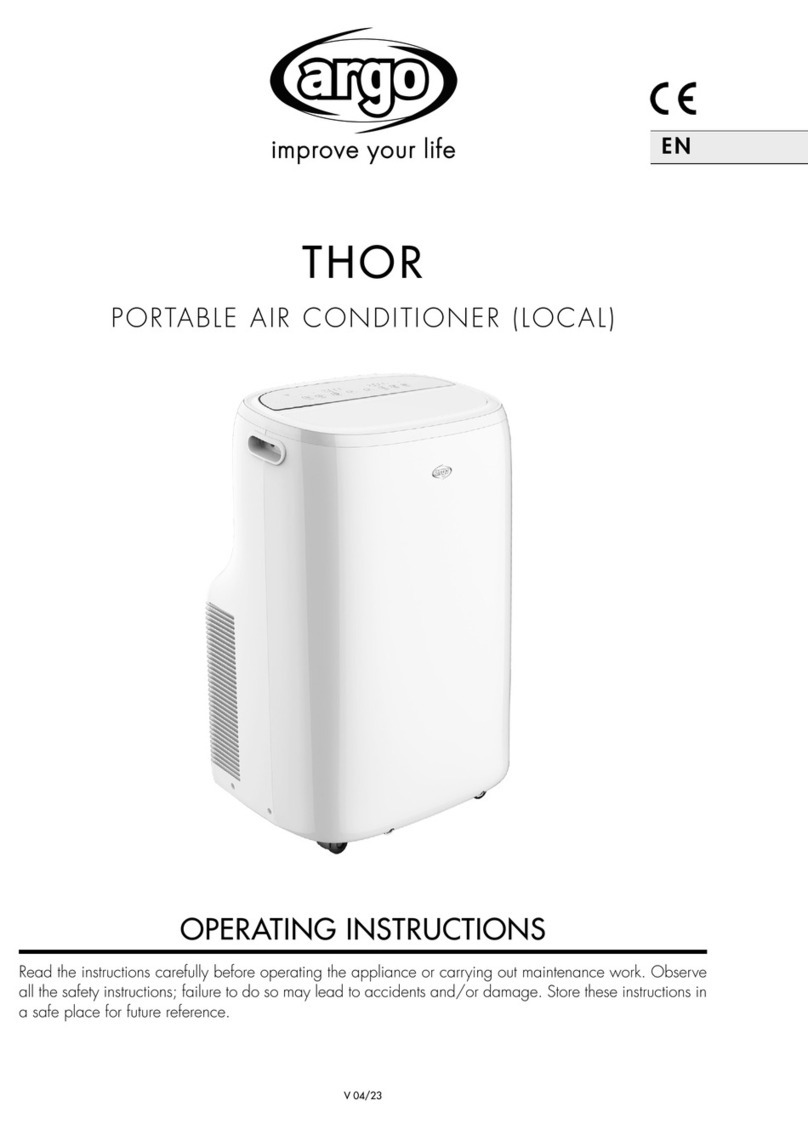
Argo
Argo THOR User manual

Argo
Argo AWR222CLE - AER222SC Operating manual
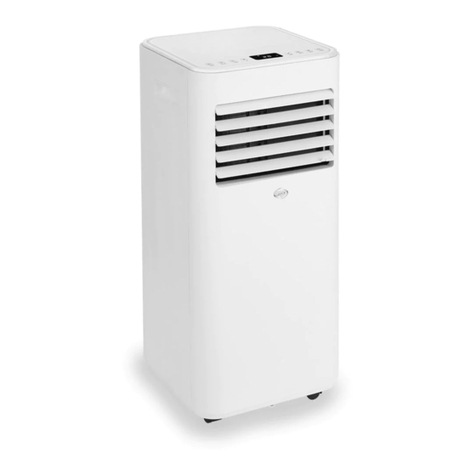
Argo
Argo ISIDE User manual
Popular Air Conditioner manuals by other brands
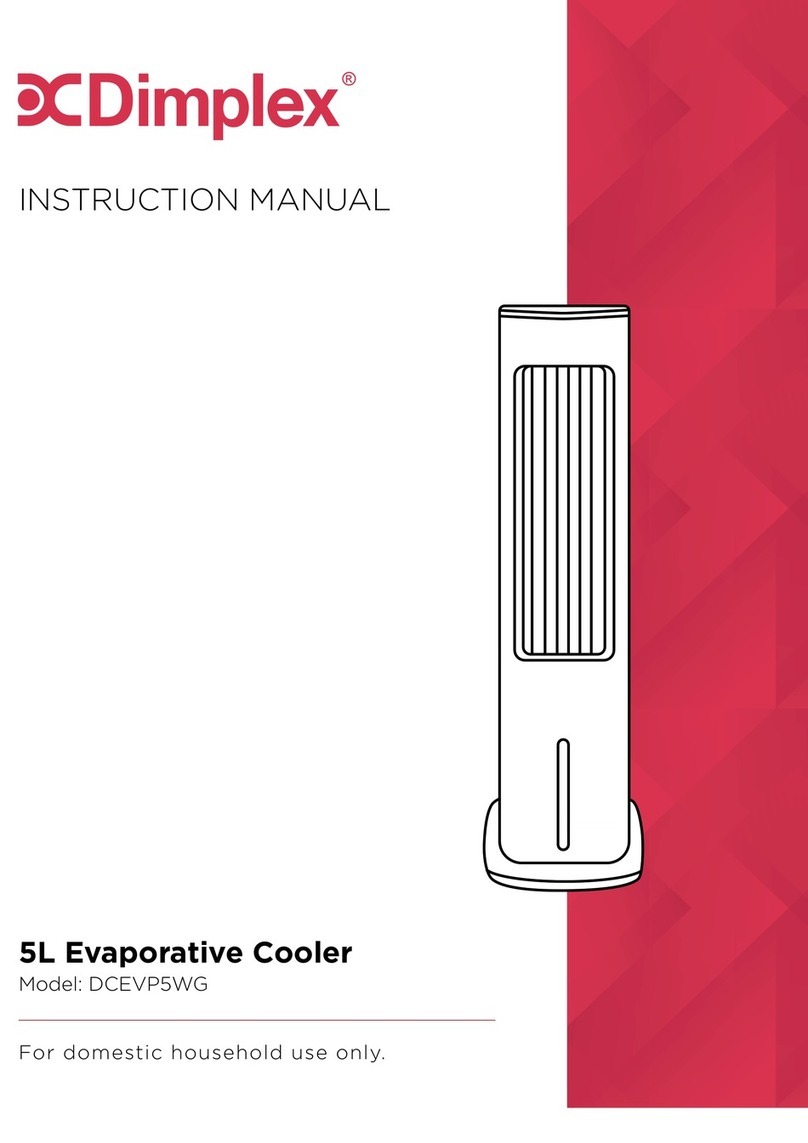
Dimplex
Dimplex DCEVP5WG instruction manual
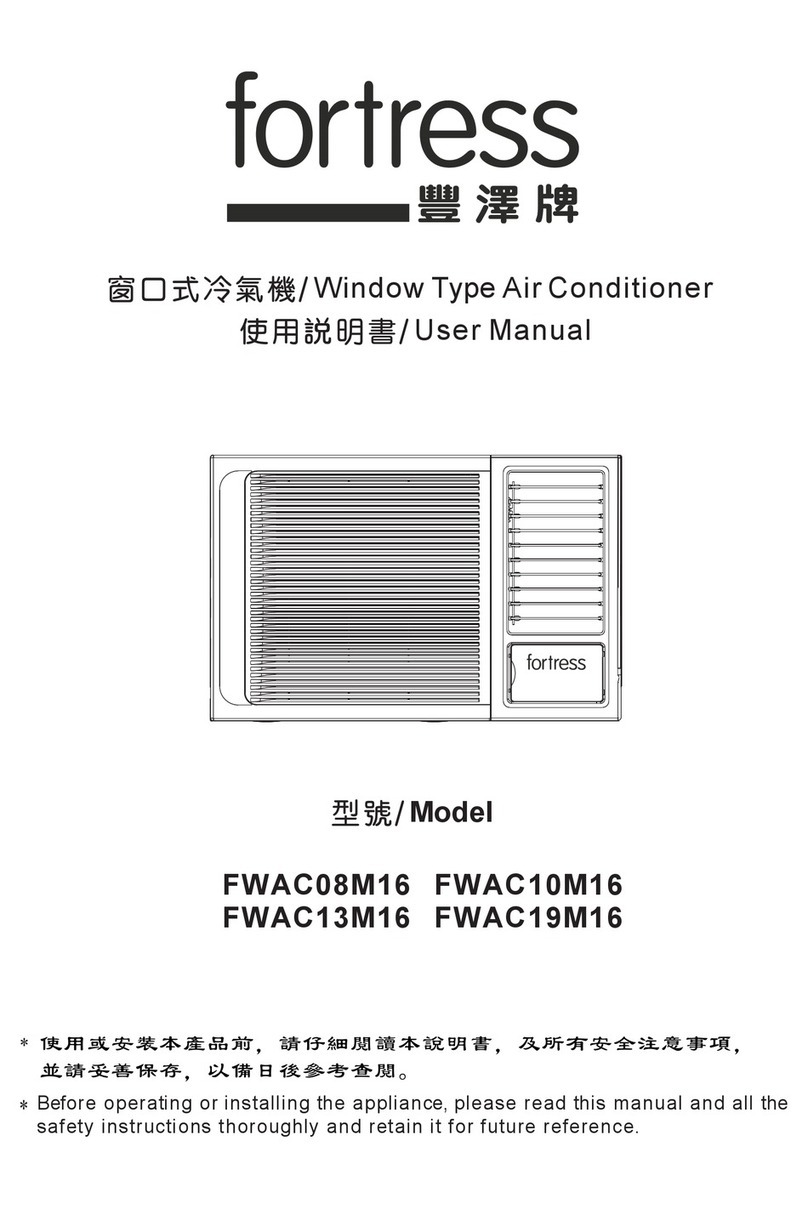
Fortress Technologies
Fortress Technologies FWAC08M16 user manual
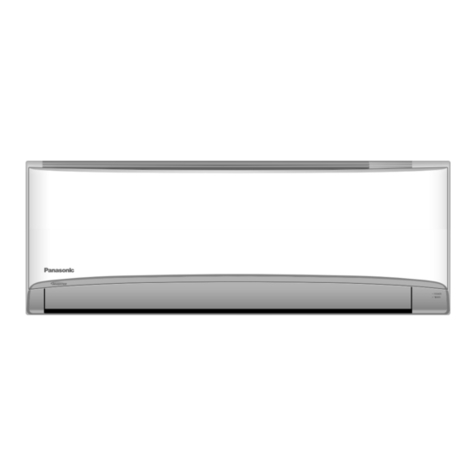
Panasonic
Panasonic CS-YS9TKV operating instructions

Convair
Convair ClimateMaster CM12RW instruction manual
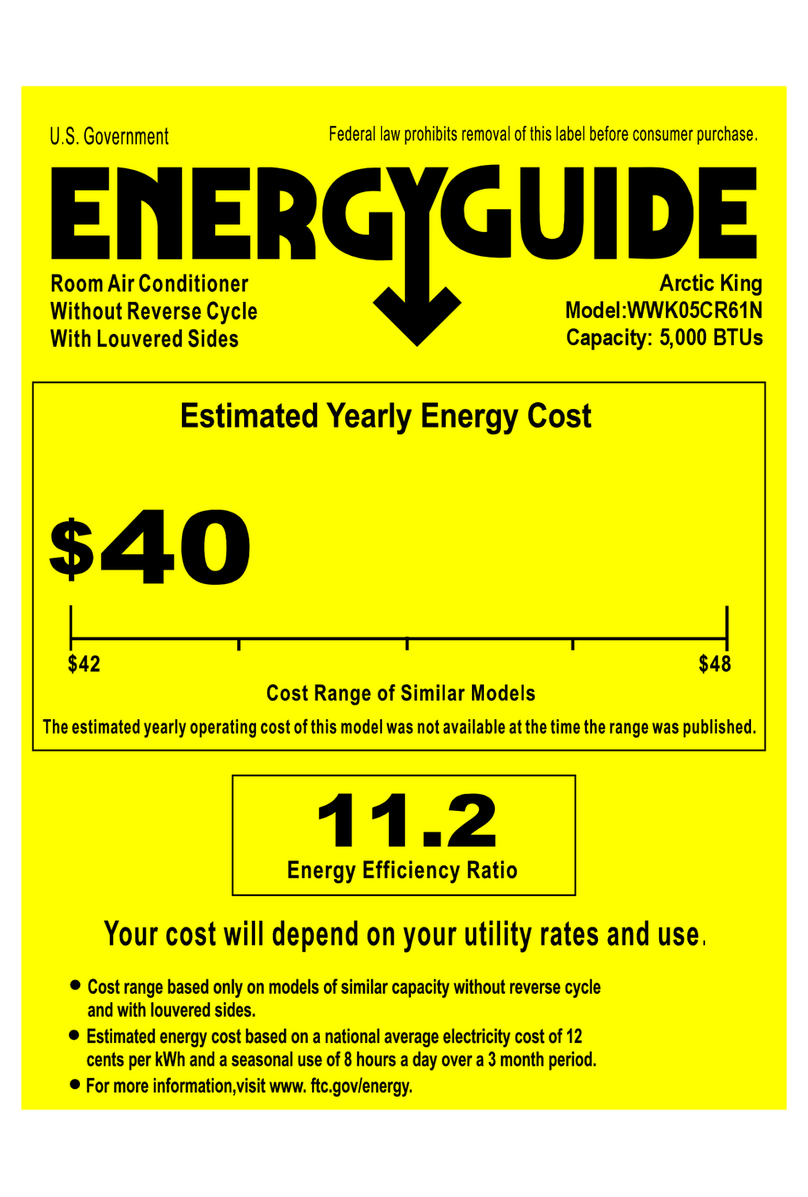
Arctic King
Arctic King wwk05cr61n Energy guide

Innova
Innova Innova Filomuro Incasso SLWI Installation and user manual

